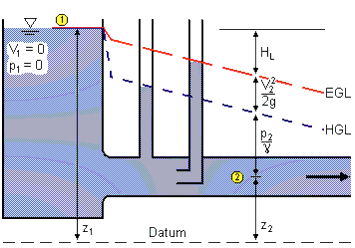Governing Equations for Steady-State Flow
Steady-state models, such as WaterCAD or WaterGEMS, are capable of two modes of analysis: steady state and extended period simulation (EPS). EPS solves a series of consecutive steady states using a gradient algorithm and accounting for mass in reservoirs and tanks (e.g., net inflows and storage). Both methods assume the system contains an incompressible fluid, so the total volumetric or mass inflows at any node must equal the outflows, less the change in storage.
In addition to pressure head, elevation head, and velocity head, there may also be head added to the system, for instance, by a pump, and head removed from the system by friction. These changes in head are referred to as head gains and head losses, respectively. Balancing the energy across two points in the system yields the energy or Bernoulli equation for steady-state flow:
- Hydraulic grade—The hydraulic grade is the sum of the pressure head (p/g ) and elevation head (z). The hydraulic head represents the height to which a water column would rise in a piezometer. The plot of the hydraulic grade in a profile is often referred to as the hydraulic grade line or HGL.
- Energy grade—The energy grade is the sum of the hydraulic grade and the velocity head (V2/2g). This is the height to which a column of water would rise in a pitot tube. The plot of the hydraulic grade in a profile is often referred to as the energy grade line or EGL. At a lake or reservoir, where the velocity is essentially zero, the EGL is equal to the HGL, as can be seen in the following figure:


